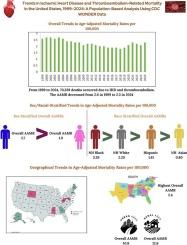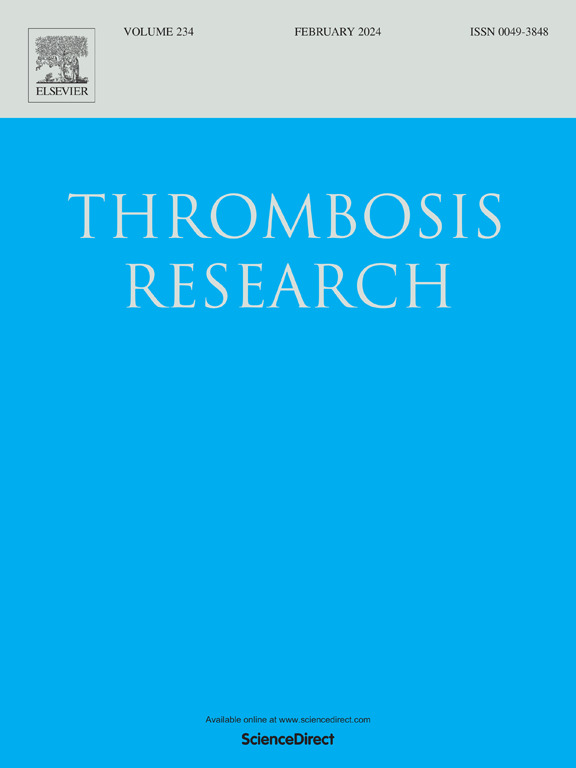Trends in ischemic heart disease and thromboembolism-related mortality in the United States, 1999–2024: A population-based analysis using CDC WONDER Data
IF 3.4
3区 医学
Q1 HEMATOLOGY
引用次数: 0
Abstract
Introduction
Ischemic heart disease (IHD) and thromboembolism continue to contribute to significant cardiovascular mortality in the United States in spite of increased prevention and treatment. Underlying both arterial and venous events, such as stroke, pulmonary embolism (PE), and deep vein thrombosis (DVT), is thrombosis. With the aging of the population and increased risk factors such as obesity and diabetes, awareness of long-term trends in mortality is needed. In this article, CDC WONDER data are used to assess national trends in IHD- and thromboembolism-associated mortality from 1999 to 2024, with attention given to variation by age, sex, and race/ethnicity to inform future public health programs.
Methods
Mortality data for IHD-thromboembolism among those aged ≥45 in the US were extracted from the CDC WONDER (1999–2024), using ICD codes I20-I25 (IHD) and I74, I26, I80-I82 (thromboembolism). Age-adjusted mortality rates were calculated per 100,000 and stratified by age, sex, race/ethnicity, geographic region, and urban-rural classification. Joinpoint regression was used to evaluate average annual percentage change (AAPC) and annual percentage change (APC) with 95 % Confidence Intervals (CIs). A p-value of <0.05 was considered significant.
Results
From 1999 to 2024, 70,339 deaths occurred due to IHD and thromboembolism. The AAMR decreased from 2.6 in 1999 to 2.3 in 2024 with an AAPC of −1.16 (95 % CI: −0.58 to −1.82). The AAMR initially inclined to 2.7 in 2001 with an APC of 1.95 (95 % CI: 5.40 to −1.94) followed by a drastic decline to 1.8 till 2018 with an APC of −2.40 (95 % CI: −2.18 to 4.90), afterward, the AAMR again incline to 2.3 in 2021 with an APC of 7.62 (95 % CI: −10.01 to −2.03). The stratified analysis revealed the highest AAMRs across the age group 85 years and older (16.03). Men consistently had higher AAMR than Women (AAMR: 2.7 vs. 1.9). By race, the highest AAMR was noted among NH Black or African American (3.4), followed by NH white (2.2). Regionally, the South showed the highest AAMR (2.4). Non-Metropolitan exhibited the highest AAMR than Metropolitan (AAMR: 12.6 vs. 10.8).
Conclusion
Despite an overall stable age-adjusted mortality trend of ischemic heart disease and thromboembolism between 1999 and 2024, the most recent years have witnessed a disturbing rise. The most notable disparities persist by age, sex, race, and geographic area, with the largest burden in older adults, men, racial minorities, non-metropolitan residents, and residents of the Midwestern U.S. These findings emphasize the need for targeted interventions and equitable public health interventions to reduce mortality among high-risk groups.

1999-2024年美国缺血性心脏病和血栓栓塞相关死亡率趋势:基于CDC WONDER数据的人群分析
在美国,尽管加强了预防和治疗,缺血性心脏病(IHD)和血栓栓塞仍然是造成心血管疾病死亡率的主要原因。潜在的动脉和静脉事件,如中风、肺栓塞(PE)和深静脉血栓形成(DVT),都是血栓形成。随着人口老龄化和肥胖、糖尿病等风险因素的增加,有必要认识到死亡率的长期趋势。在本文中,CDC WONDER数据用于评估1999年至2024年IHD和血栓栓塞相关死亡率的全国趋势,并关注年龄、性别和种族/民族的变化,为未来的公共卫生计划提供信息。方法从CDC WONDER(1999-2024)中提取美国≥45岁人群的IHD-血栓栓塞死亡率数据,使用ICD代码I20-I25 (IHD)和I74、I26、I80-I82(血栓栓塞)。计算每10万人的年龄调整死亡率,并按年龄、性别、种族/民族、地理区域和城乡分类分层。采用联结点回归对平均年变化百分比(AAPC)和年变化百分比(APC)进行评价,置信区间为95%。p值为0.05被认为是显著的。结果1999年至2024年,共有70339人死于IHD和血栓栓塞。AAMR从1999年的2.6下降到2024年的2.3,AAPC为- 1.16 (95% CI: - 0.58 ~ - 1.82)。AAMR最初在2001年倾向于2.7,APC为1.95 (95% CI: 5.40至- 1.94),随后急剧下降至1.8,直到2018年APC为- 2.40 (95% CI: - 2.18至4.90),随后,AAMR在2021年再次倾向于2.3,APC为7.62 (95% CI: - 10.01至- 2.03)。分层分析显示,85岁及以上年龄组的AAMRs最高(16.03)。男性的AAMR始终高于女性(AAMR: 2.7 vs. 1.9)。按种族划分,NH黑人或非裔美国人的AAMR最高(3.4),其次是NH白人(2.2)。从地区来看,南方的AAMR最高,为2.4。非大都市地区的AAMR高于大都市地区(AAMR: 12.6比10.8)。结论:尽管缺血性心脏病和血栓栓塞的年龄调整死亡率在1999年至2024年间总体稳定,但近年来出现了令人不安的上升趋势。最显著的差异存在于年龄、性别、种族和地理区域,老年人、男性、少数种族、非大都市居民和美国中西部居民的负担最大。这些发现强调了有针对性的干预和公平的公共卫生干预的必要性,以降低高风险群体的死亡率。
本文章由计算机程序翻译,如有差异,请以英文原文为准。
求助全文
约1分钟内获得全文
求助全文
来源期刊

Thrombosis research
医学-外周血管病
CiteScore
14.60
自引率
4.00%
发文量
364
审稿时长
31 days
期刊介绍:
Thrombosis Research is an international journal dedicated to the swift dissemination of new information on thrombosis, hemostasis, and vascular biology, aimed at advancing both science and clinical care. The journal publishes peer-reviewed original research, reviews, editorials, opinions, and critiques, covering both basic and clinical studies. Priority is given to research that promises novel approaches in the diagnosis, therapy, prognosis, and prevention of thrombotic and hemorrhagic diseases.
 求助内容:
求助内容: 应助结果提醒方式:
应助结果提醒方式:


